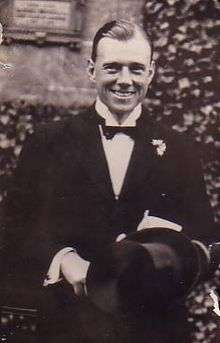Bertram Willes Dayrell Brooke
| Bertram Brooke | |
|---|---|
 His Highness the Tuan Muda of Sarawak | |
| Born | 8 August 1876 |
| Died | 15 September 1965 (aged 89) |
| Spouse | Gladys Milton Palmer |
| Issue | Anthony Brooke |
| Father | Charles Brooke, Rajah of Sarawak |
Captain Bertram Willes Dayrell Brooke, Tuan Muda of Sarawak (8 August 1876 at Kuching – 15 September 1965 at Weybridge, Surrey[1]) was a member of the family of White Rajahs who ruled Sarawak for a hundred years. He was the son of Charles, the second of these rajahs, and a brother of Vyner of Sarawak, the third and final ruler of that family. He was for some years heir presumptive to his brother, a claim he relinquished in favour of his son. He held the title of "Tuan Muda" (literally "Little Lord") and the style of "His Highness".
Brooke was educated at Winchester College and at Trinity College, Cambridge. He was president of Cambridge University Boat Club and rowed in the Boat Race in 1900 and 1901,[2] and he was a member of the Pitt Club.[3] He went on to serve in the Royal Horse Artillery during the First World War and act as Special Commissioner from Sarawak to the UK.
He married Gladys Milton Palmer (8 January 1884 – 12 June 1952) on 28 June 1904. She was the only child of Sir Walter Palmer, 1st Baronet MP and his wife, Jean, Lady Palmer, and as wife of the Tuan Muda took the title of "Dayang Muda" and the style of "Her Highness". In 1922 she formed a film company which produced just one film. She converted to Islam in Paris in 1939, taking the name Khair un-nisa binti 'Abdu'llah.[4]
They had one son, Anthony, sometime Rajah Muda of Sarawak, and two daughters.
Brooke is buried at Sheepstor Churchyard, Devon, along with the White Rajahs.
See also
References
- ↑ The Peerage
- ↑ "Brooke, Bertram Willes Darrel (BRK897BW)". A Cambridge Alumni Database. University of Cambridge.
- ↑ Fletcher, Walter Morley (2011) [1935]. The University Pitt Club: 1835-1935 (First Paperback ed.). Cambridge: Cambridge University Press. p. 93. ISBN 978-1-107-60006-5.
- ↑ Women and the Silent British Cinema